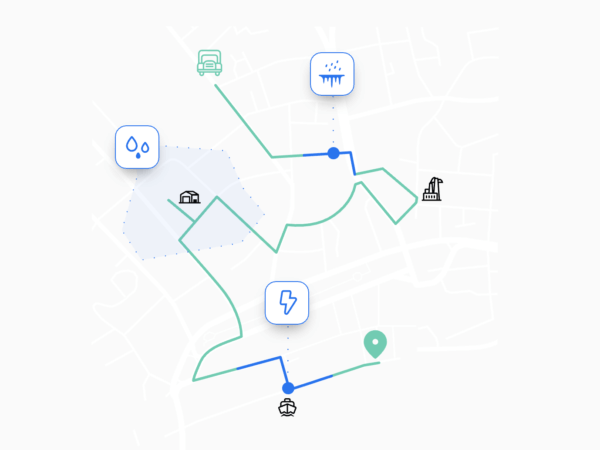TL;DR:
- Autonomous vehicles are impacted by bad weather, which can reduce the functionality of their technology.
- Weather can decrease radar functionality and decrease the range of electric AVs.
- Incorporating weather data into AV operating systems can improve consumer trust and safety.
- The Road Risk Score assesses driving risks based on weather conditions and can be integrated into AV operating systems.
- The Tomorrow.io API allows for real-time weather integration, route optimization, and alerts to avoid dangerous weather conditions.
Autonomous vehicles are cutting-edge technology, but surprisingly, they’re impacted by one of the most traditional challenges in the world: the weather. Sometimes autonomous vehicles and weather won’t mix.
While AVs, also known as self-driving cars, have to adapt to various road safety conditions, the weather can quickly throw a wrench into the works.
From icy road conditions to low visibility from fog, there are various ways that weather can make driving hazardous. But weather can be even more treacherous for AVs.
Because autonomous vehicles use technology like radar and lidar to navigate, bad weather can significantly impact the functionality of these cars. If it’s too foggy or raining too hard, even the most advanced AV may not be able to drive anywhere at all.
So what can you do? Adapt to the weather and plan accordingly.
Here is why every self-driving car needs to incorporate weather data for a safer driving future.
How Weather Impacts Self-Driving Cars
It’s evident that weather poses risks for any driver on the road today, but why does it matter even more for self-driving cars and electric vehicles?
Autonomous vehicles need to be able to “see” in bad weather. The Department of Transportation even requires developers to declare what types of weather their self-driving cars can operate in.
Most AVs and self-driving cars navigate via radar, often combined with cameras and lidar. These high-resolution sensors help cars see everything from a bend in the road to a pedestrian crossing the street.
However, this exciting technology is also vulnerable to the weather. There are several additional risks posed by weather, including:
- Radar Functionality: MMW radar can be reduced by 55% during severe precipitation.
- Vehicle Range: For electric AVs, warm weather conditions decrease range by up to 17% and cold weather conditions decrease range by up to 41%.
These two weather-driven problems are huge sticking points for adopting and purchasing AVs and electric vehicles. If drivers are worried about the functionality of their self-driving car, it defeats the purpose. It makes it seem risky to let go of the wheel at all.
What is Road Risk?
So, how can you improve consumer trust in AVs operating during difficult weather conditions? You can incorporate weather data into your car operating system.
In order to understand how the weather impacts vehicles specifically, Tomorrow.io created a 5-point rating scale that assesses the driving risks of specific weather, up to 18 hours before the AV reaches the impacted area.
The Road Risk Score incorporates observed and forecasted weather, including precipitation intensity, precipitation type, frost likelihood, visibility, and more. The score is ranked from 1 (“low risk) to 5 ( “severe or extreme risk”).
- Low Risk: There is little-to-no discernible weather-related risk right now. Skies are generally clear, and there hasn’t been precipitation lately.
- Low-Moderate Risk: You’re probably looking at either some precipitation, like rain or lowered visibility due to fog or mist.
- Moderate Risk: There’s probably a combination of precipitation, lowered visibility, and slick roads.
- High Risk: Visibility is likely to be low, precipitation is probably occurring, and roads are likely to be slippery with ice, frost, or snow.
- Extreme Risk: Visibility is bad, and precipitation is a given. Heavy snow is probable, and roads are likely to be slick. Alternatively, flooding could be present.
These levels of risk are calculated based on specific criteria for weather such as amount of rain, snow, or flooding. And the road risk score is updated in real-time as the forecast changes.
Optimize Autonomous Vehicles for Weather Along Any Route

Tomorrow.io’s weather API allows businesses to understand how bad weather impacts autonomous vehicles along set routes.
With the Tomorrow.io API, you can directly integrate road risk into any operating system and understand the weather along any route. This enables you to:
- Understand how weather conditions are going to affect routes by specific location and time.
- Visualize weather information on any map, including in-car navigation.
- Send alerts about actions to take along each mile of the journey to avoid dangerous weather conditions as they arise.
- Update the accuracy of ETAs based on weather conditions along any route.
Using the API, any driver can fully understand the risks before they make a trip. Even better, the AVs operating system can automatically adjust to the weather conditions, re-routing around dangerous weather conditions, and adjusting ETAs along the way.
With this type of powerful weather data, it’s easier to see how autonomous vehicles, self-driving cars, and even electric vehicles can be more quickly adopted by the public. With safety features that ensure functionality in even the worst weather, it’s clear that AVs are where the future is heading.




